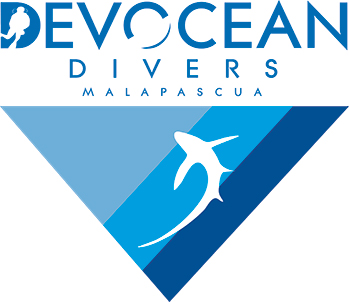Deep Rock
Depth: 14-28 Meters
Appropriate for: Advanced Open Water Divers, Enriched Air Nitrox, UW Photography
Deep Rock, or Bogtong Bato as it’s locally known is a pinnacle rising out of the seabed at 28 meters. With the top of the pinnacle 14 meters deep, it’s an ideal site for advanced divers using enriched air nitrox. With two large resident frogfish, ornate ghost pipefish and a huge variety of nudibranch, it’s also favorite of macro photographers, although anyone can appreciate the walls of colorful soft coral and feather stars galore. Strong currents can also make for surprising fish encounters, with the occasional school of trevally or barracuda spotted.
Lighthouse
Depth: 5-10 Meters
Appropriate for: Open Water Divers, Student Divers, Sunset Dives, UW Photography
Lighthouse is a shallow dive site located in one of the most protected bays around Malapascua. During the day, it’s a great site for training dives, but it really comes alive at night. A colony of mandarinfish living in the staghorn coral emerge at sunset to perform their elaborate mating ritual, rising into the water column in pairs to release their sperm. Seahorses also make their home on this reef, and when the sun goes down a huge variety of shrimp, crabs and cephalopods can be seen, including the adorable and tiny bobtail squid and the starry night octopus.
Ka Osting
Depth: 6-15 Meters
Appropriate for: Student Divers, Open Water Divers, UW Photography, Night Dives
A sloping reef leading to a sandy bottom littered with coral bommies, this is one of our dive guides’ favorite sites as it gives them an opportunity to put their spotting skills to the test. Slowly cruising over the sandy bottom can reveal fascinating critters such as ghost pipefish, frogfish, dragonets, mantis shrimp and even super macro creatures like hairy shrimp and pygmy seahorse. It’s also a popular choice for night dives.
Chocolate Island
Depth: 8-15 Meters
Appropriate for: Open Water Divers, UW Photography
A small island close to the port of Maya on Cebu, about 20 minutes boat ride from Malapascua. It’s a shallow, mellow dive that always has something different to offer. You’ll see more nudibranch and flatworms here than almost any other site, including large sea hares and spanish dancers. Robust and ornate ghost pipefish are often seen, and during winter months this is one of the best places to spot blue ringed octopus and flamboyant cuttlefish.
Deep Slope / North Point
Depth: 11-23 meters
Appropriate for: Advanced Open Water Divers, Enriched Air Nitrox, UW Photography
One of the most popular Malapascua dive sites, this sloping reef on the northeast side of Malapascua has some of the most beautiful corals around the island and also some of the most diverse marine life. Pygmy seahorse are the signature critter, but ornate ghost pipefish, frogfish, flamboyant cuttlefish, blue ringed octopus and even the occasional green sea turtle can all be found here. Due to the depth, enriched air nitrox is recommended but far from necessary.
Lapus Lapus / Lapus II
Depth: 15-22 meters
Appropriate for: Open Water Divers, UW Photography
This pair of dive sites extending out from the northwestern tip of Malapascua feature some fascinating underwater topography, consisting of a series of ravines and overhangs overgrown with soft corals, anemones and feather stars. Eagle eyed dive guides can find frogfish and pygmy seahorse, as well as plenty of colorful reef fish to entertain divers of all skill levels.
Dakit-Dakit
Depth: 6-12 Meters
Appropriate for: Open Water Divers, Night Dives
Large hard coral formations scattered around a sandy bottom in the shallow waters around this small island make for a relaxing, colorful dive. Due to the depth and proximity to the dive center, this is one of the best places for a proper night dive, offering a perfect opportunity to get away from other divers and have a private moment with rare species of nocturnal marine life.
Monad Shoal
Depth: 12-30 Meters
Appropriate for: Advanced Open Water Divers, Enriched Air Nitrox
A world famous dive site, Monad Shoal is a seamount over 1.5km long located about 20 minutes boat ride from Malapascua. The shallowest part of the shoal is about 12 meters underwater, sloping out into depths inacessible by recreational scuba divers. This is the home of the thresher sharks, who come up from the deep water to frequent “cleaning stations,” or swarms of cleaner wrasse who pick the bacteria and parasites off their bodies. The sharks are best seen between 6-8 AM, which necessitates early morning departure from Malapascua. Lucky divers can also spot mantas and mobular rays cruising past the edge of the shoal. Enriched Air Nitrox is a must for anyone with the appropriate certification, nearly doubling your available bottom time.
Kimud Shoal
Depth: 15-40 Meters
Appropriate for: Advanced Open Water Divers
Neighboring its more famous big brother, Kimud is a much smaller seamount rising up from the ocean floor in between Cebu and Leyte. During the months of February to March, divers come here in the early morning for a chance to see schools of scalloped hammerhead sharks passing by in the blue. With a large portion of the dive conducted in open water with no reference, this is for thrill-seeking divers willing to take a chance on the shark encounter of a lifetime.
